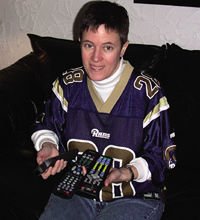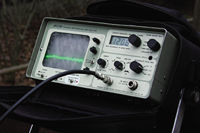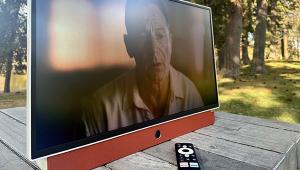Baby Steps to HDTV Page 2
 Since my antenna only yielded one true HD channel, I pursued the last option: cable TV. I've been asking Cablevision for a couple of years now when HDTV cable will be available in my neighborhood. Each time, I hear the equivalent of, "Don't hold your breath." So, when the cable installer suddenly arrived with a Scientific-Atlanta Explorer 4200HD cable box the day before the Super Bowl, I was elated. He came equipped with the box, component video cables, and stereo RCA cables. I asked him about a digital coaxial cable, which stumped him; he said HD boxes were brand new to him. He was still learning about HD, and coaxial cables weren't in the training manual.
Since my antenna only yielded one true HD channel, I pursued the last option: cable TV. I've been asking Cablevision for a couple of years now when HDTV cable will be available in my neighborhood. Each time, I hear the equivalent of, "Don't hold your breath." So, when the cable installer suddenly arrived with a Scientific-Atlanta Explorer 4200HD cable box the day before the Super Bowl, I was elated. He came equipped with the box, component video cables, and stereo RCA cables. I asked him about a digital coaxial cable, which stumped him; he said HD boxes were brand new to him. He was still learning about HD, and coaxial cables weren't in the training manual.
We tuned into HBO HD, and the installer was mesmerized by the stunning image that flowed to the edges of my 16:9 display. He asked how expensive an HDTV is. He now wants HDTV, too. Like me, though, he'll have little to watch for now. Only three HD channels currently come through my cable box: HBO HD, Fox Sports NY, and MSG. Except for HBO, most of the material is upconverted.
In January, when Cablevision told me that it's not up to them to make HDTV available, I pointed out that Time Warner Cable in New York has contracted with the major networks to deliver HDTV to their subscribers. If Cablevision would pay the retransmission fees and make channels available to the local broadcasters, I'd be able to get HDTV just like my neighbors in Manhattan do. I'm waiting for local channels, Discovery HD Theater, and the imminent ESPN HD. Cablevision's only commitment for additional channels is to "continue to expand the product," a comment attributed to Kristin Dolan, Cablevision's vice president of digital product management.
For an extra $20 a month, I could get Showtime HD, but my allowance for TV programming is now deep in the red. I pay over $60 a month for DirecTV, which I won't give up because of its broadcast-channel quality, NFL football package, and TiVo integration. Cablevision's Interactive Optimum (iO) Silver package runs me $65 a month for local broadcast channels and standard cable channels, including A&E, American Movie Classics, Animal Planet, Bravo, BET, CNN, Comedy Central, Discovery Channel, the History Channel, ESPN, ESPN2, Food Network, IFC, Metro Traffic & Weather, the Weather Channel, Sci-Fi Channel, USA Network, and 37 other analog channels. The 27 digital channels include BET on Jazz, Biography Channel, Discovery Civilization, and National Geographic Channel. I get digital music channels, and my movie package includes 11 HBOs (including HBO HD), six STARZ! channels, and six Encore channels.
 For another $5 a month, I could get HBO on Demand, which allows me to record a movie and watch it whenever I want within a 24-hour period, with the ability to pause, record, and fast-forward as I please. I can do that with my DirecTV receiver's TiVo function, though, without the 24-hour window.
For another $5 a month, I could get HBO on Demand, which allows me to record a movie and watch it whenever I want within a 24-hour period, with the ability to pause, record, and fast-forward as I please. I can do that with my DirecTV receiver's TiVo function, though, without the 24-hour window.
As for the Super Bowl, the HD broadcast looked far better than the NTSC broadcast, but there was a strange effect that neither Scientific-Atlanta nor Cablevision could explain. The definition was sharp, and the color was pure, but the motion was filmlike. It looked like I was watching a movie about the Super Bowl rather than the live game in full-motion video. If the occasional strange effect is the price I have to pay for HDTV as the technology advances, I'm a willing guinea pig. Keep it coming, ABC. And Cablevision: Be an HD leader, not a follower. One of your stockholders—Mark Cuban—has a really nice 24-hour channel called HDNet. Check it out.
Meanwhile, I'm looking forward to the fall season, when Late Show with David Letterman goes HD and CBS will deliver at least one NFL game per week in HD. I'll watch almost anything as long as it's in high definition. I find myself watching movies I wouldn't otherwise tune in to just to see the widescreen presentation, brilliant color, and razor-sharp detail on HBO HD. Did you know that Shrek wore a burlap shirt? You can almost feel the texture when you watch the movie in HD. Still, my favorite shows are on NBC, and it would be awfully nice to be able to see them in the best quality possible.
Sometimes even NTSC programming gets a boost from my digital set's performance. I used TiVo to record A Charlie Brown Christmas, and the vibrant colors popped off the screen in a way that I had never seen on an analog TV. It was like going from a box of 64 crayons to a box of 120. Widescreen DVDs look terrific on a set that's up to the challenge of the improved-definition format.
 As we transition to the DTV/HDTV era, there are a few caveats. Lower-quality DBS signals don't always translate on a digital TV, which is something I've noticed on digital TVs from various respected manufacturers. A lot of DirecTV programming looked better on my old, analog rear-projection TV. "Going through the multiple analog-to-digital conversions is one factor," says Bill Whelan, Hitachi's senior product and marketing manager. Because of line-doubling, he says, "you're seeing twice as much information on the new set than you were on the old set. Digital TVs either show off the really good signals or they expose the flaws in the bad signals." He suggests looking at the Sci-Fi Channel and then flipping to HBO to see how the higher-quality signals respond to line-doubling. I've noticed it even on DirecTV's NFL Sunday Ticket. A high-profile game has a better picture than a game between, say, Arizona and Cincinnati.
As we transition to the DTV/HDTV era, there are a few caveats. Lower-quality DBS signals don't always translate on a digital TV, which is something I've noticed on digital TVs from various respected manufacturers. A lot of DirecTV programming looked better on my old, analog rear-projection TV. "Going through the multiple analog-to-digital conversions is one factor," says Bill Whelan, Hitachi's senior product and marketing manager. Because of line-doubling, he says, "you're seeing twice as much information on the new set than you were on the old set. Digital TVs either show off the really good signals or they expose the flaws in the bad signals." He suggests looking at the Sci-Fi Channel and then flipping to HBO to see how the higher-quality signals respond to line-doubling. I've noticed it even on DirecTV's NFL Sunday Ticket. A high-profile game has a better picture than a game between, say, Arizona and Cincinnati.
Aspect ratios are another quirk in the transition from analog to digital TV. Manufacturers are grappling with how to handle the sidebars that result when you watch a 4:3 program on a 16:9 screen. Hitachi offers settings for 4:3 standard, 4:3 expanded, 4:3 zoom 1, and 4:3 zoom 2. The only one that I can watch comfortably is 4:3 standard, and I've selected gray bars to reduce the chance of burn-in on the sides of my screen. The 4:3 expanded mode stretches the outside of the picture to fill the screen, but this mode makes my head spin. The zoom options also fill the screen, but they lop off information on the top and bottom of the picture in the process. The Hitachi set offers standard and zoom options for the 16:9 aspect ratio, too, and they yield similar results. My eyes can only totally relax when I watch an HD signal that completely fills the screen. I don't have to tune out the bars on the sides or on the top and bottom of the screen. I'll be watching CBS HD and HBO HD a lot.
So, after several baby steps toward HDTV, what's the verdict? I'm enjoying the crumbs of programming that I get now, and I'm hungry for a full plate. In fact, I'll take everything on the menu.
The Price of HDTV: $6,274
Hitachi 57XWX20B Ultravision Digital TV with Integrated ATSC Tuner $4,799
Channel Master Model 4228
UHF Antenna $80
Channel Master Titan 2 Preamplifier $95
Channel Master Model 9521A Rotator $90
Antenna Installation $430
Cablevision iO Silver
Programming Package $65/month
- Log in or register to post comments










































